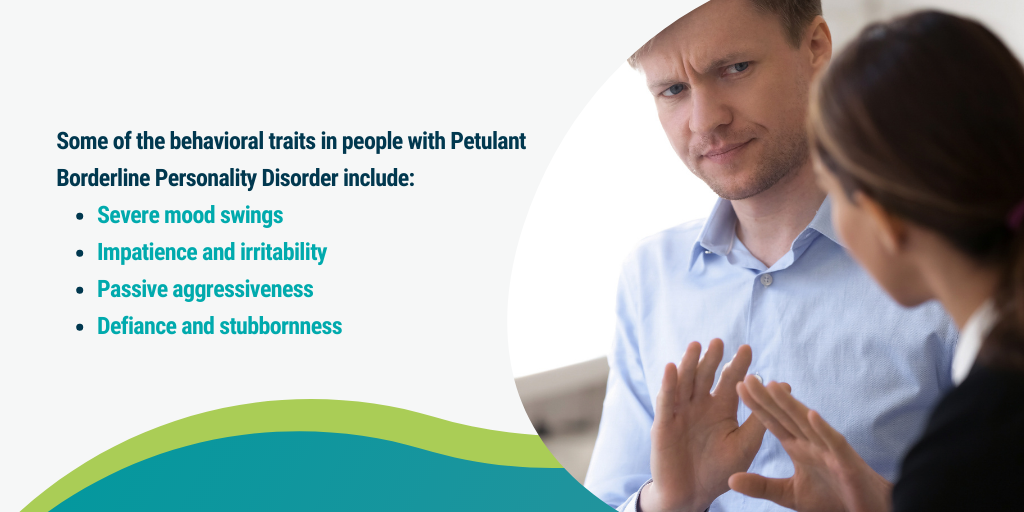
There are four widely accepted types of borderline personality disorder (BPD): discouraged, impulsive, petulant, and self-destructive BPD. You can suffer more than one kind of BPD simultaneously or at different stages in your life. Similarly, it is also possible for your condition not to fit any of these types of BPD.
Most people with mental health problems often face challenges with emotion regulation, have relationship problems, and engage in impulsive behavior. These categories of borderline personality disorder can overlap significantly, but some symptoms, such as anger and aggressiveness, might vary considerably.
This article discusses the four widely recognized types of borderline personality disorder, including the distinct characteristics that define them.
1. Discouraged Borderline Personality Disorder
Discouraged BPD is also referred to as Quiet BPD. People suffering from this borderline personality disorder are usually afraid of abandonment. Therefore, they tend to take extreme actions to prevent imagined and real abandonment.
Compared to individuals with other types of BPD, people with discouraged BPD keep their emotions hidden. It has also been observed that they like blaming themselves instead of others.
People with discouraged BPD may:
- Be perfectionists
- Be high functioning
- Be very successful
- Feel like they lack strong bonds with others
- Feel alienated and detached in social groups
- Engage in self-harm
- Engage in suicidal behavior
- Seek approval but also self-isolate
- Feel lonely and empty most of the time
Common signs and symptoms of discouraged borderline personality disorder include but are not limited to:
- Neediness
- Clinginess
- Anger
- Emotional mood swings
- Codependency
2. Impulsive Borderline Personality Disorder
Impulsive behavior is one of the primary symptoms of borderline personality disorder. People with BPD tend to act in impulsive and dangerous ways. More often than not, they behave this way without regard for other people or possible consequences.
People with impulsive BPD may appear:
- Energetic
- Charismatic
- Detached or elusive
- Motivating or engaging
- Flirtatious
Examples of impulsive behaviors include but are not limited to:
Aggressive behaviors: physical fights, outbursts, hitting things, breaking things, yelling fits.
Bingeing behaviors: overspending, binge eating, and binge watching.
Self-destructive and risky behavior: driving under the influence, sex with multiple partners, unprotected sex, gambling, doing illicit drugs, and excessive consumption of alcohol.
3. Petulant Borderline Personality Disorder
People with this type of borderline personality disorder may appear angry one moment and sulky or sad the next. They swing unpredictably between emotions. They may also feel unloved or unworthy. This can lead to an unhealthy desire for control and relationship challenges.
People with petulant BPD can also be very manipulative. They often feel dissatisfied in their relationships. As a result, it is easier for them to result to substance abuse and other dangerous behaviors.

4. Self-Destructive Borderline Personality Disorder
People with self-destructive BPD battle with self-hatred and often feel bitter about it. Examples of behavioral traits found in people with this type of borderline personality disorder include:
- Self-harm behaviors: These may include burning, cutting, hitting, and scratching.
- Substance abuse: this includes both prescription medications and recreational drugs.
- Risky adrenaline-seeking activities: people with self-destructive BPD engage in such activities without preparing for them in advance.
- Threats of suicide
Symptoms of self-destructive borderline personality disorder are similar to those of other categories.
Additional symptoms that help set it apart include:
- A decrease in the desire to sleep.
- An increase in energy.
- Feelings of euphoria.
However, these can also be signs of a manic episode or bipolar disorder rather than a self-destructive borderline personality disorder. It is imperative that you talk to a board-certified mental health professional to be sure you are getting the right treatment.
What Causes BPD?
Like all other psychological disorders, it is difficult to pinpoint the precise causes of borderline personality disorder. That notwithstanding, industry experts agree that interactions among biology, environment, and genetics play a role in its development.
While having any combination of these factors may result in the onset of borderline personality disorder symptoms, this is not always the case for everyone. Conversely, some people may lack these risk factors and still end up developing BPD.
Possible causes of BPD include but are not limited to:
Brain anomalies: research studies have linked brain anomalies with the development of borderline personality disorder. These studies indicate that brain structure and function variations can account for symptoms such as impulsiveness and emotional instability.
Genetics: Evidence also suggests that borderline personality disorder may be genetic. People with close relatives with this condition could be at a higher risk of developing BPD.
Childhood Trauma: numerous cases of borderline personality disorder have been linked to childhood trauma. Those with BPD report experiencing traumatic events such as sexual abuse, abandonment, neglect, emotional abuse, and physical abuse during childhood.
Treating Borderline Personality Disorder
The various types of borderline personality disorder have different treatment modalities. These modalities may include a combination of medications for managing specific BPD symptoms and various talk therapy modalities.
Research shows that each of the four types of BPD reflects biologically determined temperaments that can be linked to neuro-biologically based vulnerabilities and predispositions. Treatment for BPD varies depending on the type of BPD and from person to person.
It’s also worth noting that BPD is not necessarily treatable using medication. This is true because no medication has been discovered or approved to cure this mental health condition.
However, prescription medications are often used to help manage BPD symptoms such as mood swings and anxiety. Medications can also effectively lower the risk of self-harm and prevent suicide.
The common talk therapy modalities used to treat borderline personality disorder are:
- Dialectical behavioral therapy: For Discouraged, impulsive, petulant, and self-destructive BPD.
- Cognitive behavioral therapy: For discouraged, impulsive, and petulant BPD.
- Mentalization-based therapy: For discouraged and petulant BPD.
- Psychodynamic therapy: For petulant BPD.
- Schema-focused therapy: For petulant BPD.
Talk therapy helps identify triggers, which makes it easier to learn how to manage any mental health disorder, including borderline personality disorder.
Borderline Personality Disorder Help
If you think you or a loved one is showing signs of Borderline Personality Disorder (BPD), it’s important to seek professional help as soon as possible. BPD can be difficult to diagnose and manage without the right guidance, so seeking the help of a qualified mental health professional is essential.
At My Psychiatrist, we have a team of experts who specialize in diagnosing and treating BPD. Our professionals provide personalized care and develop tailored treatment plans to suit each individual client’s needs. We have offices in South Florida and offer virtual consultations for clients throughout the state.

